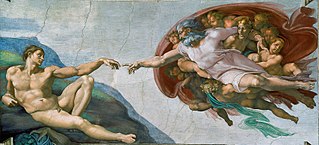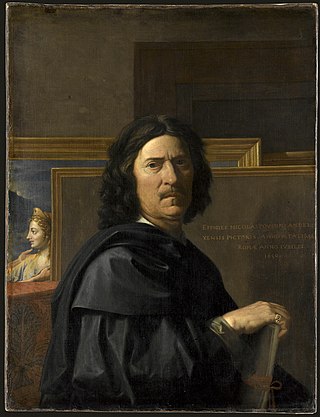| Image | Year | Painter | Title | Notes | Current location / status |
|---|
| 1630 | Georges Lallemant | Saints Peter and Paul Climbing Up To The Temple | | Saint-Chéron, parish church |
| 1631 | Pierre-Antoine Lemoine | The Miracle of the Madonna | | Lost |
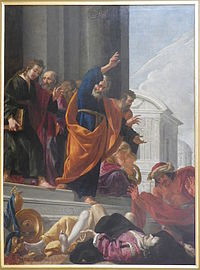 | 1632 | Aubin Vouet | The Deaths of Ananias and Sapphira | | Rouen, musée des Beaux-Arts |
| 1633 | Georges Lallemant | Saint Stephen Praying Before His Martyrdom | | Lost |
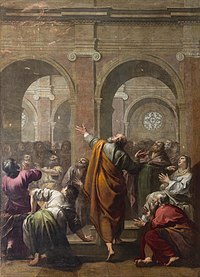 | 1634 | Jacques Blanchard | The Descent of the Holy Spirit | | Paris, cathédrale Notre-Dame |
 | 1635 | Laurent de La Hyre | Saint Peter Curing the Sick By His Shadow | | Paris, cathédrale Notre-Dame |
| 1636 | Jacques de Létin | Saint Paul Preaching on the Areopagus | | Destroyed in 1870; previously Strasbourg, musée des Beaux-Arts |
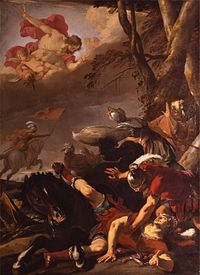 | 1637 | Laurent de La Hyre | The Conversion of saint Paul | | Paris, cathédrale Notre-Dame |
 | 1638 | Claude Vignon | The Baptism of Queen Candace's Eunuch | | Lost |
 | 1639 | Aubin Vouet | The Centurion Cornelius at Saint Peter's Feet | | Paris, cathédrale Notre-Dame |
 | 1640 | Aubin Vouet | The Freeing of Saint Peter | | Toulouse, musée des Augustins |
| 1641 | Nicolas Prévost | The Beheading of Saint James | | Lost |
 | 1642 | Charles Poerson | Saint Peter Preaching in Jerusalem | | Paris, cathédrale Notre-Dame |
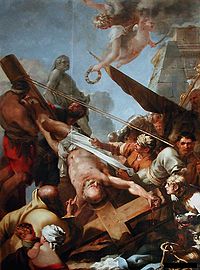 | 1643 | Sébastien Bourdon | The Crucifixion of Saint Peter | | Paris, cathédrale Notre-Dame |
 | 1644 | Michel Corneille l'Ancien | Saint Paul and Saint Barnabas at Lystra | | Arras, musée des Beaux-Arts |
| 1645 | Charles Errard | Saint Paul Regains His Sight | | Lost |
| 1646 | Louis Boullogne | Saint Paul's Miracle at Ephesus | | Arras, musée des Beaux-Arts |
| 1647 | Charles Le Brun | The Crucifixion of Saint Andrew | | Paris, cathédrale Notre-Dame |
| 1648 | Louis Boullogne | The Martyrdom of Saint Simon | | Arras, musée des Beaux-Arts |
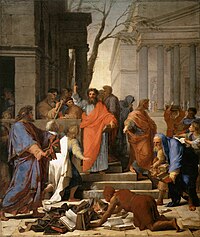 | 1649 | Eustache Le Sueur | Saint Paul Preaching at Ephesus | | Paris, musée du Louvre |
| 1650 | Nicolas Loir | Saint Paul Blinding the False Prophet Barjesus and Converting the Proconsul Sergius | | Paris, cathédrale Notre-Dame |
 | 1651 | Charles Le Brun | The Stoning of Saint Stephen | | Paris, cathédrale Notre-Dame |
 | 1652 | Louis Testelin | Saint Peter Reviving the Widow Tabitha | | Arras, musée des Beaux-Arts |
| 1653 | Charles Poerson | Saint Paul Bitten by a Snake on Malta | | Lost |
| 1654 | Zacharie Heince | The Conversion of Lydia | | Lost |
| 1655 | Louis Testelin | The flagellation of Saint Paul and Saint Silas | | Paris, cathédrale Notre-Dame |
| 1656 | Étienne Villequin | Saint Paul Delivering Agrippa | | Lyon, église Saint-Pothin |
| 1657 | Louis Boullogne | The Beheading of Saint Paul | | Paris, musée du Louvre |
| 1658 | Michel Corneille l'Ancien | Saint Peter at Caesarea | | Toulouse, église Saint-Pierre |
| 1659 | René Dudot | Saint Peter Reviving the Widow Tabitha | | Lost |
| 1660 | Antoine Paillet | The Martyrdom of Saint Bartholomew | | Lyon, cathédrale Saint-Jean |
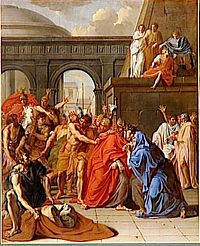 | 1661 | Noël Coypel | Saint James Being Led to Torture, Curing a Paralysed Man and Embracing His Accuser | | Paris, musée du Louvre |
 | 1662 | Daniel Hallé | The Martyrdom of Saint John at the Latin Gate | | Clermont-Ferrand, musée d'Art Roger Quillot |
| 1663 | Thomas Blanchet | The Rapture of Saint Philip | | Arras, musée des Beaux-Arts |
| 1664 | Jérôme Sorlay | Christ Appears to Saint Peter | | Versailles, cathédrale Saint-Louis |
| 1665 | Zacharie Heince | Saint Peter and Simon the Magician | | Lost |
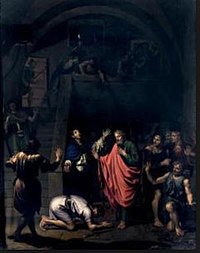 | 1666 | Nicolas de Plattemontagne | Saint Paul et Silas | | Paris, musée du Louvre |
| 1667 | Jean-Baptiste de Champaigne | Saint Paul's Martyrdom at Lystra | | Marseille, musée des Beaux-Arts |
| 1668 | Claude-François Vignon | Saint Bartholomew Healing the King of Armenia's Daughter | | Lost |
| 1669 | Louis Boullogne | The Ascension | | Lost |
| 1670 | Gabriel Blanchard | Saint André trésaille de joie à la vue de son supplice | | Paris, cathédrale Notre-Dame |
| 1671 | Jean-Baptiste de Cany | The Conversion of Saint Dionysius the Areopagite at Athens | | Lost |
| 1672 | Michel Corneille le Jeune | The Calling of Saint Peter and Saint Andrew | | Arras, musée des Beaux-Arts |
| 1673 | Jean Jouvenet | Jesus Healing a Paralysed Man | | Lost (destroyed in 1944 in the chapel of the École militaire de Saint-Cyr) |
| 1674 | Claude II Audran | The Beheading of Saint John the Baptist | | Paris, musée du Louvre |
| 1675 | René-Antoine Houasse | The Vision of Saint Stephen | | Paris, musée du Louvre |
| 1676 | Michel Ballin | Saint Paul and Saint Barnabas Separate | | Lost |
| 1677 | François Verdier | The Resurrection of Lazarus | | Paris, église Saint-Germain-des-Prés |
| 1678 | Bon Boullogne | Christ Healing a Paralysed Man at the Baths of Bethseda | | Arras, musée des Beaux-Arts |
| 1679 | Jean-Baptiste Corneille | The Freeing of Saint Peter | | Lost |
| 1680 | Antoine Coypel | The Assumption of the Virgin | | Mirande, église Sainte-Marie |
| 1681 | Alexandre Ubelesqui | The Baptism of Christ | | Lost |
| 1682 | Jean Cotelle | The Marriage at Cana | | Yssingeaux, église Saint-Pierre |
| 1683 | no may | | no may | |
| 1684 | Charles-François Poërson | Christ Healing the Sick at Gennesaret | | Saint-Symphorien-en-Laye, église Notre-Dame |
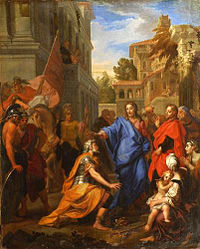 | 1685 | Louis de Boullogne | The Centurion at Christ's Feet | | Arras, musée des Beaux-Arts |
| 1686 | Claude Guy Hallé | Jesus Driving the Money-Changers out of the Temple | | Arras, musée des Beaux-Arts |
 | 1687 | Louis Chéron | The Prophet Agabus Predicting to Saint Paul What He Would Suffer At Jerusalem | | Paris, cathédrale Notre-Dame |
| 1688 | Guy-Louis Vernansal | Christ Reviving Jairus' Daughter | | Arras, musée des Beaux-Arts |
| 1689 | Louis Chéron | Salome Carrying the Head of John the Baptist | | Lost |
| 1690 | Simon Guillebault | Christ Reviving the Widow of Nain's Son | | Larchant, église Saint-Martin |
| 1691 | Alexandre Ubelesqui | Christ Healing the Sick | | Paris, musée du Louvre |
| 1692 | Arnould de Vuez | The Incredulity of Saint Thomas | | Lyon, cathédrale Saint-Jean |
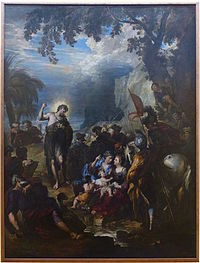 | 1693 | Joseph Parrocel | Saint John the Baptist Preaching | | Arras, musée des Beaux-Arts |
| 1694 | no may | | no may | |
| 1695 | Louis de Boullogne the younger | Christ and the Samaritan Woman | | Wardour Castle, Wiltshire |
| 1696 | Joseph Christophe | The Miracle of the Loaves | | Lost |
| 1697 | François Marot | Christ Appearing to the Three Marys | | Lost |
| 1698 | Joseph Vivien | The Adoration of the Magi | | Lost |
| 1699 | François Tavernier | The Repentance of Saint Peter | | Lost |
| 1700 | Guy-Louis Vernansal | Christ and the Deaf-Mute Boy Possessed by an Evil Spirit | | Lost |
| 1701 | Étienne Regnault | Christ and the Woman Caught in Adultery | | Lost |
| 1702 | Mathieu Elias | Sceva's Children Attacked by a Demon | | Paris, cathédrale Notre-Dame |
| 1703 | Louis de Silvestre | Saint Peter Curing a Paralysed Man at the Temple Gate | | Arras, musée des Beaux-Arts |
 | 1704 | Claude Simpol | Christ in the House of Martha and Mary | | Arras, musée des Beaux-Arts |
| 1705 | Louis Galloche | Saint Paul Departs for Miletus | | Paris, musée du Louvre |
| 1706 | Pierre-Jacques Cazes | The Curing of the Woman with a Flow of Blood | | Arras, musée des Beaux-Arts |
 | 1707 | Jacques Courtin | Saint Paul preaching at Troad and Reviving the young Eutychus | | Toulouse, cathédrale Saint-Étienne |






















